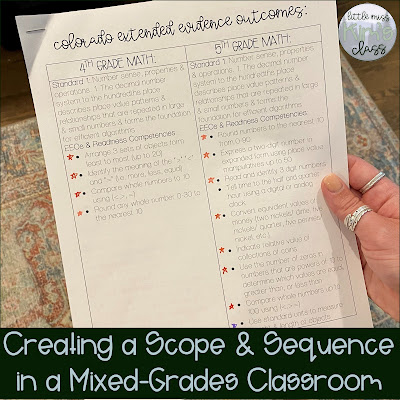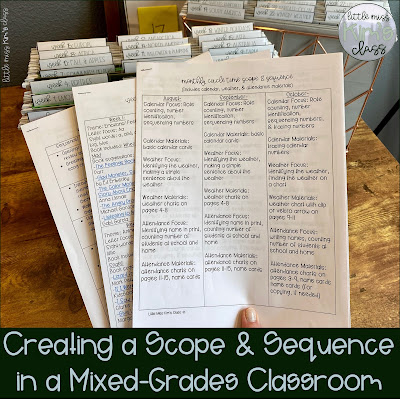
Something that has helped me with this SO much over the years is creating scope & sequences for content areas (math, reading, morning meeting, science, social studies, etc). Scope & sequences are also great because they remove the question "What am I going to teach next week?" and ensure that you cover all of the standards/ IEP goals required.
What are scope & sequences and how are they helpful?
- Scope & sequences are also often called curriculum maps.
- A scope & sequence lays out the content that will be taught (the standards, IEP goals, etc.), the order that the content will be taught & often also includes materials and activities for lessons.
- They help you plan how you will teach different standards/ skills across lessons and units.
- If you have boxed curriculum in your classroom, it likely includes a scope and sequence. However, many special education teachers don't have boxed curricula that meets the needs of all of our students... So creating a scope & sequence based on your state standards and your students' needs is a great alternative!
Steps for creating a Scope & Sequence:
- Start by creating chart or document with all of the standards for each grade you teach. I start with one content area at a time. I make charts in a Word Doc for Math, Reading, Science and Social Studies. This year I only have 4th-5th grade, but I also did this when I taught K-5. These charts will help you look at all of the grade level standards at one time.
- Now it's time to start grouping standards that have similar outcomes/ tasks. Here is an example of how I did this for 4th and 5th grade math standards > I color-coding standards that aligned with each other (i.g. there are multiple 4th and 5th grade standards that relate to money). After I grouped all of the standards with similar outcomes, I identified 13 broad math units. I picked 13 because that would allow me to do 3 week math units, but you can pick whatever number of units that works for your classroom and standards. I know this is harder when you're planning out more than a two grade levels, but it's doable with creativity!
- Now you're going to create another chart (sorry!) for each unit. I put each grade level side by side for each unit. For each unit, you can include:
- The standards you're targeting
- IEP goals you will target
- Materials you will use or activities to do
- How you'll differentiate
- Any other important information or reminders!
- (I left some of this information off of the scope & sequences I'm sharing due to confidentiality)
Creating scope & sequences can definitely take a few hours for each content area (depending on how in depth you make them and how much info you add), but they will save you time in the long run! I pretty much use them as my "lesson plans" and guide for the entire school year, so it saves me a lot of planning time during the school year!
If you're looking for math units to use with your scope & sequence, check out this bundle of math units! Each unit includes differentiated worksheets, hands-on centers & digital Google Slides!








Hi there,
ReplyDeleteI have a question. What do you suggest for students who are not developmentally ready for the content/standards? I have 4 students who will technically be 1st graders but did not master any Kindergarten Standards.
I am a self-contained sped teacher. I recommend looking back at some older standards and scaffold where necessary. It's okay to add lower grade work in a station or assignment for some of your students to do if you can connect the standards.
DeleteI love the way you broke this down to create your scope and sequence. Thank you for sharing.
ReplyDeleteThank you so much! I've taught for many years and have never done a scope and sequence. How is that even possible? Through lots of tears and regret. Thanks for helping me get my life back.
ReplyDeleteI am glad to see that you have it broken up by months not by days. I am lucky if I can get a lesson done in 3 days.
ReplyDeleteI have 4 grade levels, 2nd - 5th, but most of the students are around K-2nd grade level. Do you have any advice?
ReplyDeleteI would love to see the scope and sequence sold or even a template sold - it would be SO. helpful!
ReplyDeleteHi nice reading yoour blog
ReplyDeleteNice share
ReplyDelete